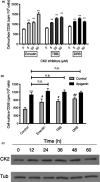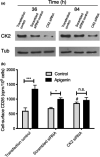Apigenin upregulation of CD26/DPPIV on colon epithelial cells requires inhibition of casein kinase 2
- PMID: 33133535
- PMCID: PMC7590318
- DOI: 10.1002/fsn3.1823
Apigenin upregulation of CD26/DPPIV on colon epithelial cells requires inhibition of casein kinase 2
Abstract
CD26/DPPIV is a cell surface glycoprotein found on cells of the intestinal epithelium including those of the colon. We have previously shown that the dietary flavone apigenin (4',5,7-trihydroxyflavone) upregulates CD26/DPPIV on colon cells. Flavonoids such as apigenin interfere with the action of multiple cellular protein kinases and have the capacity to modulate the cell exterior and its ability to interface with the local environment through different signaling pathways. We show here that the ability of apigenin to upregulate CD26/DPPIV is exerted through and requires the activity of casein kinase 2 (CK2). Inhibitors of CK2 that are distinct from apigenin (emodin, 6-methyl-1,3,8-trihydroxyanthraquinone; TBB, 4,5,6,7-tetrabromobenzotriazole; and DRB, 5,6-dichlorobenzimidazole 1-β-D-ribofuranoside) showed a dose-dependent ability to increase CD26/DPPIV and had the same maximal effect when combined with apigenin at submaximal concentrations. Knockdown of CK2 with siRNA abrogated the ability of apigenin to upregulate CD26/DPPIV. Apigenin treatment of cells had no effect on the levels of CK2 protein, consistent with an inhibition of activity of the enzyme. Apigenin's upregulation of CD26/DPPIV in differentiated human colon epithelial cells depends upon inhibition of CK2 activity. This is a key step in enabling apigenin's ability to regulate the functions of intestinal epithelial cells.
Keywords: 4,5,6,7‐tetrabromobenzotriazole (TBB); 5,6‐dichlorobenzimidazole 1‐β‐D‐ribofuranoside (DRB); 6‐methyl‐1,3,8‐trihydroxyanthraquinone (emodin); CD26; DPPIV; apigenin; casein kinase 2.
© 2020 The Authors. Food Science & Nutrition published by Wiley Periodicals LLC.
Conflict of interest statement
The authors declare no conflicts of interest.
Figures





Similar articles
-
Apigenin directly interacts with and inhibits topoisomerase 1 to upregulate CD26/DPP4 on colorectal carcinoma cells.Front Pharmacol. 2022 Dec 22;13:1086894. doi: 10.3389/fphar.2022.1086894. eCollection 2022. Front Pharmacol. 2022. PMID: 36618939 Free PMC article.
-
The dietary flavonoid apigenin enhances the activities of the anti-metastatic protein CD26 on human colon carcinoma cells.Clin Exp Metastasis. 2011 Apr;28(4):337-49. doi: 10.1007/s10585-010-9364-6. Epub 2011 Feb 5. Clin Exp Metastasis. 2011. PMID: 21298326
-
Downregulating CD26/DPPIV by apigenin modulates the interplay between Akt and Snail/Slug signaling to restrain metastasis of lung cancer with multiple EGFR statuses.J Exp Clin Cancer Res. 2018 Aug 22;37(1):199. doi: 10.1186/s13046-018-0869-1. J Exp Clin Cancer Res. 2018. PMID: 30134935 Free PMC article.
-
DPPIV/CD26: a tumor suppressor or a marker of malignancy?Tumour Biol. 2016 Jun;37(6):7059-73. doi: 10.1007/s13277-016-5005-2. Epub 2016 Mar 4. Tumour Biol. 2016. PMID: 26943912 Review.
-
Regulation and roles of CD26/DPPIV in hematopoiesis and diseases.Biomed Pharmacother. 2017 Jul;91:88-94. doi: 10.1016/j.biopha.2017.04.074. Epub 2017 May 23. Biomed Pharmacother. 2017. PMID: 28448874 Review.
Cited by
-
Unveiling the power of flavonoids: A dynamic exploration of their impact on cancer through matrix metalloproteinases regulation.Biomedicine (Taipei). 2024 Jun 1;14(2):12-28. doi: 10.37796/2211-8039.1447. eCollection 2024. Biomedicine (Taipei). 2024. PMID: 38939095 Free PMC article. Review.
-
Apigenin directly interacts with and inhibits topoisomerase 1 to upregulate CD26/DPP4 on colorectal carcinoma cells.Front Pharmacol. 2022 Dec 22;13:1086894. doi: 10.3389/fphar.2022.1086894. eCollection 2022. Front Pharmacol. 2022. PMID: 36618939 Free PMC article.
-
Does Oral Apigenin Have Real Potential for a Therapeutic Effect in the Context of Human Gastrointestinal and Other Cancers?Front Pharmacol. 2021 May 18;12:681477. doi: 10.3389/fphar.2021.681477. eCollection 2021. Front Pharmacol. 2021. PMID: 34084146 Free PMC article. Review.
References
-
- Ahmad, K. A. , Wang, G. , & Ahmed, K. (2006). Intracellular hydrogen peroxide production is an upstream event in apoptosis induced by down‐regulation of casein kinase 2 in prostate cancer cells. Molecular Cancer Research, 4, 331–338. - PubMed
-
- Allada, R. , & Meissner, R. A. (2005). Casein kinase 2, circadian clocks, and the flight from mutagenic light. Molecular and Cellular Biochemistry, 274, 141–149. - PubMed
-
- Andre‐Garnier, E. , Robillard, N. , Costa‐Mattioli, M. , Besse, B. , Billaudel, S. , & Imbert‐Marcille, B. M. (2003). A one‐step RT‐PCR and a flow cytometry method as two specific tools for direct evaluation of human herpesvirus‐6 replication. Journal of Virological Methods, 108, 213–222. - PubMed
-
- Balis, M. E. (1985). Adenosine deaminase and malignant cells. Annals of the New York Academy of Sciences, 451, 142–149. - PubMed
LinkOut - more resources
Full Text Sources
Miscellaneous

